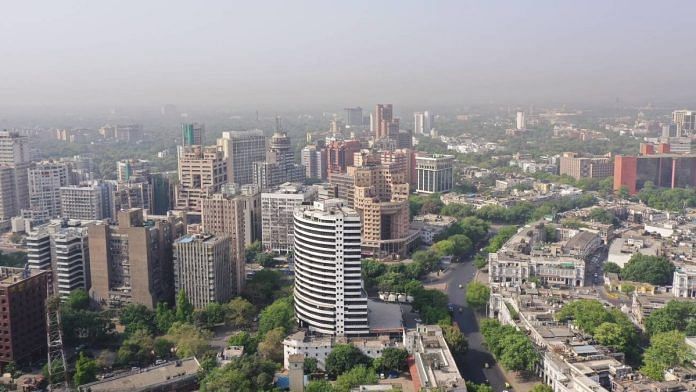New Delhi: The Modi government plans to introduce a mechanism to assess the economic potential of cities as it prepares to channel massive investment to develop them as “engines of growth,” as proposed in the Union Budget 2025-26, ThePrint has learnt.
The Ministry of Housing and Urban Affairs (MoHUA) has constituted an inter-ministerial committee, headed by economist and NITI Aayog member Arvind Virmani, to finalise the methodology for measuring City Economic Product (CEP) or city-level Gross Domestic Product (GDP).
According to senior ministry officials, CEP will play a crucial role in ensuring better socio-economic and infrastructure planning and help attract private investment. The government is looking at large-scale private investment in developing cities in the next few years.
“While the Centre is investing in the development of infrastructure through various missions, there is a need for private investment for developing infrastructure in cities,” said a senior ministry official, who didn’t want to be identified.
“If the data about city-level GDP, or CEP, is available, it will help the private sector gauge the economic potential of a city and accordingly invest in it,” the official added.
The move to develop a methodology to assess CEP comes weeks after the Modi government announced its ambitious plan to invest Rs 1 lakh crore in cities through an ‘Urban Challenge Fund’. To avail of the fund, cities will have to raise at least 50 percent of project costs from the market through bank bonds and public-private partnerships.
“This fund will finance up to 25 percent of the cost of bankable projects with a stipulation that at least 50 percent of the cost is funded from bonds, bank loans, and public-private partnership. An allocation of Rs 10,000 crore is proposed for 2025–26,” Union Finance Minister Nirmala Sitharaman said while presenting the budget.
Urban affairs ministry officials said India currently lacks a standard methodology to estimate city-level GDP. The 26-member committee—which includes government officials, as well as academics and urban planning experts—has been tasked to finalise the methodology for measuring CEP.
The committee includes officials from ministries such as finance, statistics and program implementation, and labour and employment, besides the Reserve Bank of India (RBI), seven state governments and four municipal commissions, among others.
It will define economic regions, identify parameters or indicators that can be used to estimate CEP and suggest possible data sources. “(It will also) select the most appropriate base year, deflator, etc. for estimation of the CEP in the Indian context,” said a Ministry of Housing and Urban Affairs (MoHUA) order dated 14 February.
The former director of the National Institute of Member Public Finance and Policy (NIPFP) Dr Pinaki Chakraborty, professor and dean at South Asian University Dr Arup Mitra, and Indian Statistical Institute professor Dr Deepayan Sarkar are members of the committee. Debolina Kundu, professor and director of the National Institute of Urban Affairs (NIUA), has been appointed as a member secretary of the committee.
Also Read: First set of new Central Vista office spaces to be ready by May, says Centre
A decade in the making
According to the ministry’s 14 February order, the committee is expected to submit its report by February next year.
The need for a framework to assess city-level GDP has been under discussion for nearly a decade. The Urban and Regional Development Plans Formulation and Implementation (URDPFI) guidelines notified by MoHUA mention the need for city-level GDP.
In 2019, the ministry appointed a team under the Technical Assistance for Smart Cities (TASC) programme, a part of the Smart Cities Mission, to assess the availability of data at the national, state and city levels and develop a framework to estimate city-level GDP.
The consultation paper on the City GDP measurement framework, available on the ministry’s website, lists close to 15 categories such as education, real estate and economic activities for assessing city-level GDP. “Better planning is possible if policymakers can have an estimate of the economic size and relative needs of cities. Similarly, cities can benchmark their own earnings and investment requirements against their peers once they understand their cities’ size and economic structure,” the paper said.
“While the economic potential of the larger metropolitan areas is known, the city GDP measurement exercise could unearth a number of other cities, whose potential as investment destinations are hitherto unknown,” it added.
Economic development councils (CEDCs)
In recent years, urban development experts have been pushing for better planning of city-level economic development.
A high-level committee on urban planning reforms set up by the Centre in 2022 had pushed for setting up city-level economic development councils (CEDC) to leverage the economic potential of cities.
It reiterated the need in its report, titled ‘Pathways to Amrit Kaal: Envisioning and realizing a new future for Indian cities,’ which was submitted in November last year.
The role of a CEDC will be to frame economic development strategies for the city with an objective of creating “employment and enhancing skills and stimulating local economic development,” the report said.
“CEDCs should be set up in cities with a population of one million and above. It shouldn’t be an advisory council but ensure active involvement of the business community and professionals, among others, in decision-making,” Keshav Varma, chairman of the committee, had told ThePrint last November.
(Edited by Sugita Katyal)
Also Read: Not just US, India kicked off its own ‘DOGE’ 8 years ago. Here are govt bodies that faced the axe




